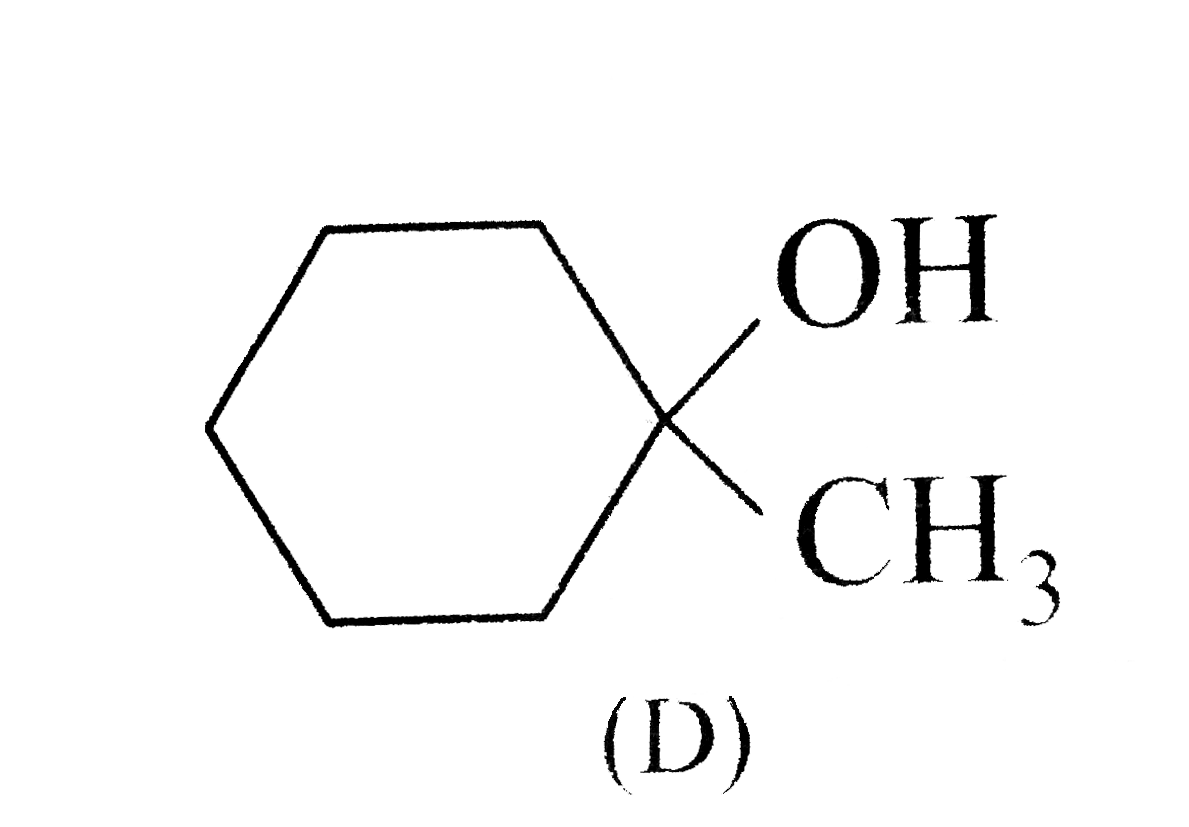Treatment of (CH3)3CCH(OH)CH3 with conc, hydrochloric acid gives two isomeric alkyl chorides. What are there two products?
To solve the problem of determining the two isomeric alkyl chlorides formed from the treatment of (CH₃)₃C CH(OH)CH₃ with concentrated hydrochloric acid, we can follow these steps:
Step 1: Identify the structure of the starting compound
The given compound is (CH₃)₃CCH(OH)CH₃, which can be represented as:
CH₃∣∣CH₃−C−CH(OH)−CH₃∣∣CH₃
This compound has a tertiary carbon (the one connected to three CH₃ groups) and a secondary alcohol group (the OH group).
Step 2: Protonation of the alcohol
When concentrated hydrochloric acid (HCl) is added, the hydroxyl group (OH) of the alcohol gets protonated to form a better leaving group (water):
CH₃
|
CH₃-C-CH₂-OH₂⁺
|
CH₃
Step 3: Formation of the carbocation
The protonation leads to the formation of a carbocation. The tertiary carbocation is more stable than the secondary one, so the protonation will lead to the formation of a tertiary carbocation:
CH₃∣∣CH₃−C⁺−CH₂∣∣CH₃
This carbocation can rearrange if necessary, but in this case, it is already stable.
Step 4: Nucleophilic attack by chloride ion
The chloride ion (Cl⁻) from HCl will then attack the carbocation, leading to the formation of alkyl chlorides. The chloride can attack from either side of the carbocation, leading to two different products.
Step 5: Identify the two products
1. First product (1-chloro-2-methylpropane): When Cl⁻ attacks the carbon adjacent to the OH group:
CH₃∣∣CH₃−C−CH₂Cl∣∣CH₃
This product can be named as 1-chloro-2-methylpropane.
2. Second product (2-chloro-2-methylpropane): When Cl⁻ attacks the tertiary carbon:
CH₃∣∣CH₃−C−CH(Cl)−CH₃∣∣CH₃
This product can be named as 2-chloro-2-methylpropane.
Conclusion
The two isomeric alkyl chlorides formed from the reaction of (CH₃)₃CCH(OH)CH₃ with concentrated hydrochloric acid are:
1. 1-chloro-2-methylpropane
2. 2-chloro-2-methylpropane
The given compound is (CH₃)₃CCH(OH)CH₃, which can be represented as:
CH₃∣∣CH₃−C−CH(OH)−CH₃∣∣CH₃
This compound has a tertiary carbon (the one connected to three CH₃ groups) and a secondary alcohol group (the OH group).
When concentrated hydrochloric acid (HCl) is added, the hydroxyl group (OH) of the alcohol gets protonated to form a better leaving group (water):
CH₃
|
CH₃-C-CH₂-OH₂⁺
|
CH₃
The protonation leads to the formation of a carbocation. The tertiary carbocation is more stable than the secondary one, so the protonation will lead to the formation of a tertiary carbocation:
CH₃∣∣CH₃−C⁺−CH₂∣∣CH₃
This carbocation can rearrange if necessary, but in this case, it is already stable.
The chloride ion (Cl⁻) from HCl will then attack the carbocation, leading to the formation of alkyl chlorides. The chloride can attack from either side of the carbocation, leading to two different products.
1. First product (1-chloro-2-methylpropane): When Cl⁻ attacks the carbon adjacent to the OH group:
CH₃∣∣CH₃−C−CH₂Cl∣∣CH₃
This product can be named as 1-chloro-2-methylpropane.
CH₃∣∣CH₃−C−CH(Cl)−CH₃∣∣CH₃
This product can be named as 2-chloro-2-methylpropane.
The two isomeric alkyl chlorides formed from the reaction of (CH₃)₃CCH(OH)CH₃ with concentrated hydrochloric acid are:
1. 1-chloro-2-methylpropane
2. 2-chloro-2-methylpropane
Topper's Solved these Questions
- BOOK - FIITJEECHAPTER - ALKYL AND ARYL HALIDESEXERCISE - SOLVED PROBLEMS [SUBJECTIVE]17videos
ALKYL AND ARYL HALIDES
- BOOK - FIITJEECHAPTER - ALKYL AND ARYL HALIDESEXERCISE - SOLVED PROBLEMS [OBJECTIVE]21videos
ALKYL AND ARYL HALIDES
- BOOK - FIITJEECHAPTER - ALDEHYDES AND KETONES EXERCISE - MATCHING LIST QUESTIONS2videos
ALDEHYDES AND KETONES
- BOOK - FIITJEECHAPTER - ATOMIC STRUCTUREEXERCISE - NUMERICAL BASED QUESTIONS INDICATED BY DIGITAL INTEGER BY XXXXX.XX2videos
ATOMIC STRUCTURE
Similar Questions
Knowledge Check
- Question 1 - Select One
The reaction of (CH3)2C(OH)CH2CH3 with copper at 300∘C gives
ACH3CO(CH3)2 and H2BCH3−C∣CH3=CH−CH3 and H2OC(CH3)2C=CHCH3 and H2ODCH3CH=CHCH2CH3 and H2 - Question 2 - Select One
The product of the reaction of (CH3)3CCH(OH)CH3 with conc. H2SO4 is
A(CH3)3CH=CH2B(CH3)2C=C(CH3)2CCH3CH2CH2CH=CH2DCH3CH2CH=CHCH3 - Question 3 - Select One
The treatment of CH3MgX with CH3−C≡C−H produces
ACH3−CH=CH2BCH3C≡C−CH2CCH3−H∣C=H∣C−CH2DCH4
Consider the reaction of the following alcohols with conc. H2SO4:
(CH3CH2)2CHCH(OH)CH3(A),PhCH2CH(OH)CH(CH3)2(B)
(CH3)3CCH(OH)CH3(C)

Which of these alcohols does not yields the expected saytzeff's product?View Solution(CH3)3C−OH on treatment with NaCl in aqueous medium gives
View Solution(CH3)3C−OH on treatment with NaCl in aqueous medium gives
View SolutionAssertion CH3CH3(CH3)NCH2CH2CH3on treatment with aqueous Hcl produces two stereo isomeric quaternary ammonium salts.
Reason salts will have a chiral centre.View SolutionCH3CH2OH and CH3−O−CH3 express which type of isomerism
View Solution

